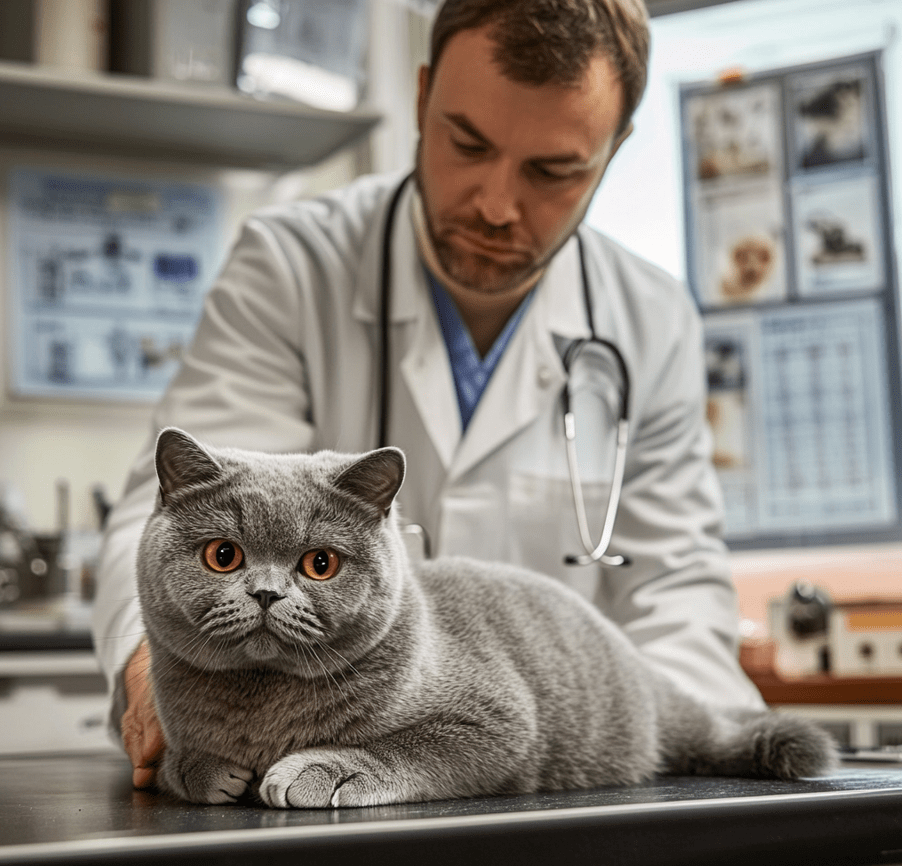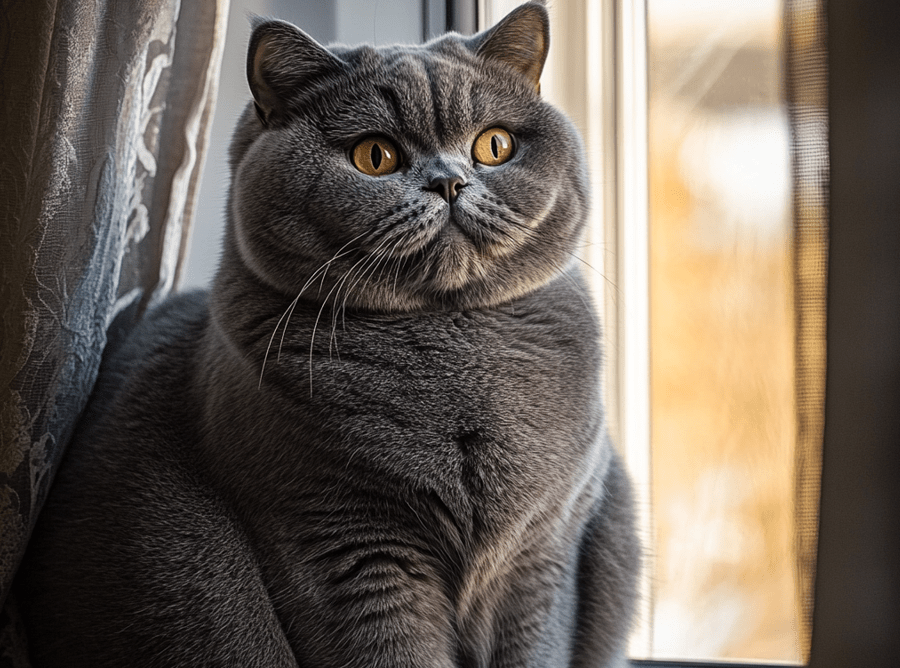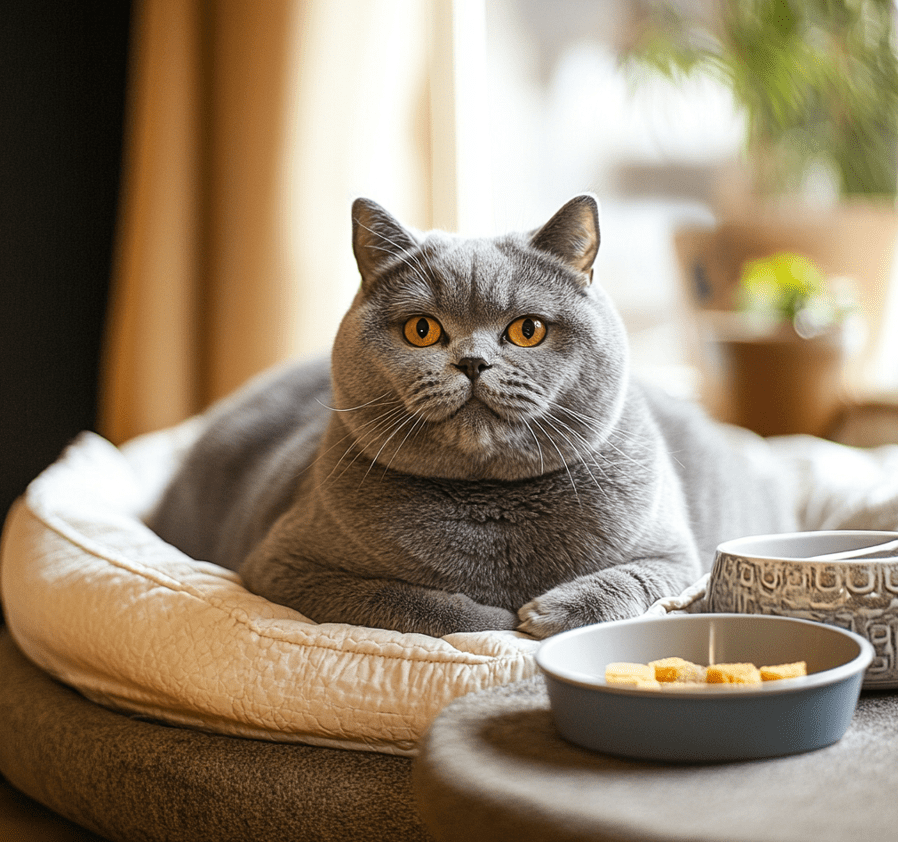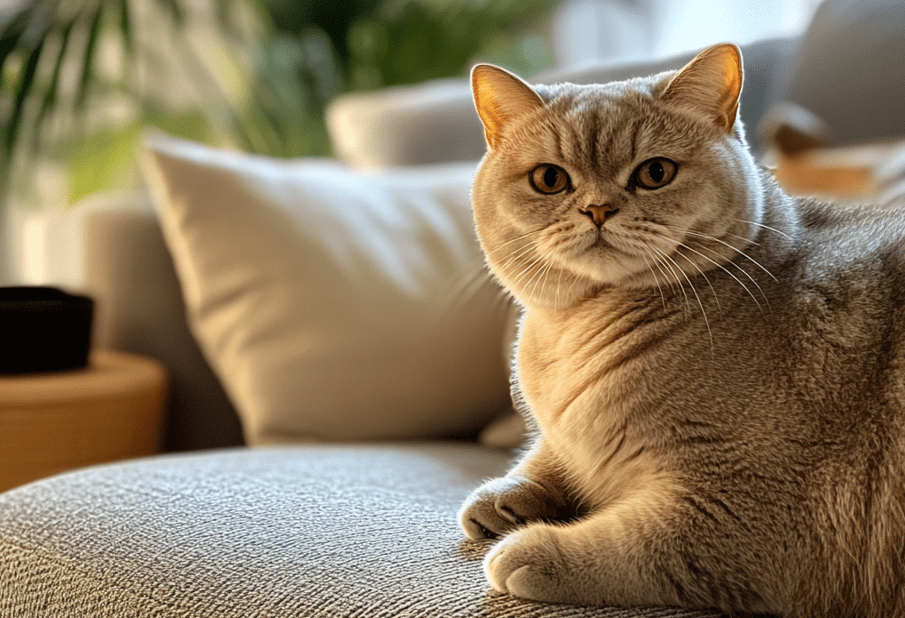
British Shorthair cats, with their plush coats, round faces, and calm, affectionate personalities, are beloved companions who thrive with proper care. However, vet visits can be stressful for these sturdy felines, known for their preference for routine. Preparing your British Shorthair for a vet visit is essential to minimize anxiety, ensure a smooth experience, and support their health. This comprehensive guide offers practical, evidence-based strategies to help you and your British Shorthair navigate vet appointments stress-free, covering preparation, transportation, and post-visit care to keep your cat comfortable and healthy.
Understanding Why Vet Visits Can Stress British Shorthairs
British Shorthairs, with their stocky builds (9-18 pounds) and laid-back nature, often dislike disruptions to their environment. Vet visits introduce unfamiliar sights, sounds, and handling, which can trigger stress responses like hiding, vocalizing, or aggression. Stress can also exacerbate health issues, such as feline lower urinary tract disease (FLUTD), to which British Shorthairs are prone. Proper preparation reduces anxiety, making the visit more productive for diagnosing and addressing health concerns like obesity, dental disease, or heart conditions common in the breed.
Why Preparation Matters
Preparing your British Shorthair for a vet visit offers several benefits:
Reduced Stress: Familiarity with carriers and routines lowers anxiety for both cat and owner.
Better Veterinary Care: A calm cat is easier to examine, leading to accurate diagnoses.
Health Monitoring: Regular, stress-free visits help catch issues early, supporting longevity.
Stronger Bond: Positive experiences reinforce trust between you and your cat.
By planning ahead, you create a positive experience that benefits your British Shorthair’s physical and emotional well-being.
Steps to Prepare Your British Shorthair for a Vet Visit
Effective preparation involves planning before, during, and after the vet visit. Below are detailed strategies to ensure a stress-free experience for your British Shorthair.

1. Choose the Right Veterinarian
Selecting a vet who understands British Shorthairs sets the stage for a positive experience.
Find a Cat-Friendly Practice: Look for clinics accredited by the American Association of Feline Practitioners (AAFP) or those with cat-specific waiting areas to reduce stress from dogs or noise.
Check Experience with British Shorthairs: Ask if the vet is familiar with breed-specific issues, like hypertrophic cardiomyopathy (HCM), obesity, or urinary problems.
Schedule a Meet-and-Greet: Introduce your cat to the vet during a non-medical visit to build familiarity. Bring treats to create positive associations.
Verify Appointment Options: Choose a vet offering early or quiet appointment times to minimize waiting and exposure to other animals.
A trusted vet familiar with your British Shorthair’s needs makes visits smoother and less intimidating.
2. Get Your Cat Comfortable with the Carrier
The carrier is often a major stress trigger, but desensitizing your British Shorthair can make it a safe haven.
Choose a Suitable Carrier: Select a hard-sided carrier with a removable top, like the Petmate Sky Kennel, sized for your cat’s sturdy frame (at least 24”L x 16”W x 15”H). Ensure good ventilation and a secure door.
Make It Familiar: Leave the carrier out year-round in a favorite spot, like near a window perch. Place soft bedding, such as a PetFusion blanket, and treats inside to encourage exploration.
Practice Short Sessions: Start by luring your cat into the carrier with toys or treats for a few minutes daily, gradually closing the door and extending the time. Reward calm behavior.
Simulate Travel: Once comfortable, carry the cat around the house or take short car rides (5-10 minutes) to mimic the vet trip experience.
Regular carrier exposure transforms it into a familiar, stress-free space.
3. Prepare Health Records and Questions
Being organized ensures the vet visit is efficient and addresses all concerns.
Gather Medical Records: Compile vaccination records, past test results, and medication details in a folder or app, like PetDesk. Note any recent symptoms, such as changes in appetite, urination, or behavior.
List Questions: Write down concerns, like weight management, dental health, or joint stiffness, to discuss with the vet. For example, ask about diet adjustments if your cat’s weight exceeds 14 pounds (ideal for most females) or 18 pounds (males).
Track Diet and Habits: Note your cat’s food brand, portion sizes, and litter box habits to provide context for urinary or digestive issues, common in British Shorthairs.
Bring Samples if Needed: If instructed, collect a fecal or urine sample in a sterile container for testing, especially for recurring urinary concerns.
Preparation ensures the vet has all the information needed for a thorough evaluation.
4. Acclimate Your Cat to Handling
Vet exams involve touching sensitive areas, which can unsettle British Shorthairs. Gradual acclimation reduces resistance.
Practice Gentle Handling: At home, gently touch your cat’s ears, mouth, paws, and belly during petting sessions, mimicking vet exams. Reward with treats, like Greenies Feline Dental Treats, for cooperation.
Open the Mouth: Use a finger to gently lift the lips to check teeth, preparing your cat for dental exams. Start with brief touches and build tolerance.
Lift and Hold: Practice lifting your cat under the chest and hindquarters, holding for a few seconds to simulate weighing or restraint. Keep sessions calm and positive.
Desensitize to Strangers: Invite friends to pet your cat occasionally, helping them adjust to unfamiliar hands.
Regular handling builds confidence, making vet exams less stressful.
5. Manage Stress Before the Visit
Reducing anxiety in the days and hours leading up to the visit sets a calm tone.
Maintain Routine: Keep feeding, play, and litter box schedules consistent to avoid unsettling your British Shorthair, who thrives on predictability.
Use Calming Aids: Place a Feliway diffuser in your home a week before the visit to release calming pheromones. Alternatively, spray the carrier with Feliway 30 minutes before departure.
Offer Enrichment: Engage your cat with puzzle feeders or feather wands the day before to reduce pent-up energy and promote relaxation.
Avoid Overstimulation: Limit loud noises or visitors on the appointment day to keep your cat’s environment serene.
A relaxed cat is more likely to handle the vet visit with ease.
6. Plan the Day of the Visit
Thoughtful planning on the appointment day minimizes stress for you and your British Shorthair.
Time Feeding Carefully: If no fasting is required, feed a small meal 2-3 hours before the visit to prevent hunger-related agitation. For procedures requiring fasting, confirm with your vet and remove food 8-12 hours prior.
Prepare the Carrier: Line it with a familiar towel or blanket scented with your cat’s bedding. Add an absorbent pad, like Pet Parents Pawtect Pads, in case of accidents.
Secure Your Cat: Place your cat in the carrier calmly, using treats or toys to lure them in. Avoid forcing them, as this increases stress. Secure the door firmly.

Cover the Carrier: Drape a lightweight towel over the carrier, leaving ventilation gaps, to reduce visual stimuli during transport.
A well-planned morning ensures a smooth departure and arrival.
7. Make Transportation Stress-Free
The car ride to the vet can be daunting, but careful planning keeps your British Shorthair calm.
Secure the Carrier: Place the carrier on the car floor or buckle it into a seat to prevent sliding. Avoid the trunk, which lacks ventilation.
Keep the Car Comfortable: Maintain a temperature of 68-72°F (20-22°C) and play soft music or keep silence to avoid startling your cat.
Drive Smoothly: Avoid sudden stops or sharp turns to minimize motion discomfort. If your cat dislikes car rides, practice short drives beforehand.
Bring Comfort Items: Include a favorite toy or a piece of your clothing in the carrier for familiar scents.
A calm car ride sets a positive tone for the vet visit.
8. Navigate the Vet Clinic Environment
The clinic can be overwhelming, but you can help your British Shorthair stay relaxed.
Arrive Early: Get to the clinic 5-10 minutes early to avoid rushing, which can heighten anxiety.
Minimize Exposure: Keep the carrier covered in the waiting area and place it on a chair or your lap, away from other pets. Request a quiet corner if available.
Stay Calm: Your British Shorthair senses your emotions, so speak softly and avoid nervous behaviors. Pet them gently through the carrier door if they’re receptive.
Communicate Needs: Inform the vet staff if your cat is anxious or aggressive, so they can adjust their approach, such as using a towel for restraint.
A composed presence helps your cat feel secure in the unfamiliar setting.
9. Support Your Cat During the Exam
Your involvement during the exam can ease your British Shorthair’s stress.
Stay Present if Allowed: If permitted, stay in the exam room to provide reassurance. Speak calmly and avoid sudden movements.
Follow Vet Guidance: Allow the vet to handle procedures but ask questions if you’re unsure about tests, like bloodwork for kidney function or X-rays for HCM.
Offer Treats Post-Exam: Reward your cat with a treat or praise after the exam to create positive associations, provided the vet approves.
Monitor Reactions: Note if your cat becomes overly stressed (e.g., panting, hissing) and inform the vet, who may pause or adjust the approach.
Your support makes the exam a collaborative, low-stress process.
10. Post-Visit Care and Recovery
After the visit, help your British Shorthair decompress and maintain health.
Create a Quiet Space: Set up a cozy area with their bed, water, and litter box for rest. Avoid loud noises or visitors for 24 hours.
Monitor Behavior: Watch for signs of stress, like hiding or reduced appetite, or side effects from vaccines/medications, such as lethargy or swelling. Contact your vet if symptoms persist beyond 48 hours.
Administer Medications: Follow prescription instructions precisely, using pill pockets or syringes for ease. For example, antibiotics for dental issues may require 7-14 days.
Schedule Follow-Ups: Book any recommended follow-ups, like bloodwork in 6 months for senior cats, to monitor conditions like kidney disease.
Post-visit care reinforces health and trust, preparing your cat for future appointments.
Common Health Concerns Addressed at Vet Visits
British Shorthairs have breed-specific health risks that vet visits help monitor and manage. Preparing for these discussions ensures thorough care.

Obesity: Excess weight strains kidneys, joints, and the heart. Vets may recommend diet changes or exercise plans if your cat’s body condition score exceeds 5/9.
Hypertrophic Cardiomyopathy (HCM): This heart condition requires periodic ultrasounds or blood tests to detect early signs, like murmurs.
Feline Lower Urinary Tract Disease (FLUTD): Urinalysis checks for crystals or infections, common in British Shorthairs due to low thirst drive.
Dental Disease: Regular exams prevent gingivitis or tooth resorption, which can cause pain and stress.
Allergies or Skin Issues: Itching or hair loss may indicate fleas or environmental allergies, requiring tests or treatments.
Discussing these with your vet ensures proactive management of your cat’s health.
Tips for Specific Situations
Certain scenarios require tailored preparation for your British Shorthair’s vet visit.
Kittens (8-16 Weeks)
Vaccination Schedule: Prepare for core vaccines (FVRCP) at 8, 12, and 16 weeks. Bring a toy to distract during injections.
Socialization: Expose kittens to carriers and handling early to build lifelong comfort.
Spay/Neuter Prep: If scheduled, confirm fasting instructions (typically 8 hours) and bring a cone if provided.
Early positive experiences shape stress-free vet visits as adults.
Senior Cats (10+ Years)
Comfort Focus: Use padded carriers and minimize travel time, as seniors may have arthritis or reduced stamina.
Health Monitoring: Expect bloodwork or urine tests to check kidney, thyroid, or heart function, common concerns in older British Shorthairs.
Gentle Handling: Inform the vet of mobility issues, so they use soft tables or limit restraint.
Extra care ensures seniors remain calm and healthy.
Emergency Visits
Stay Calm: In urgent cases (e.g., urinary blockage, lethargy), focus on quick transport while keeping your cat secure.
Bring Essentials: Include medical records and a list of symptoms (e.g., vomiting frequency) for rapid diagnosis.
Call Ahead: Alert the clinic to prepare for emergencies, like oxygen for breathing issues or fluids for dehydration.
Preparation even in crises improves outcomes.
Common Mistakes to Avoid
When preparing your British Shorthair for a vet visit, steer clear of these pitfalls:
Last-Minute Carrier Use: Storing the carrier away until the visit day creates fear. Keep it accessible year-round.
Skipping Desensitization: Forcing an unprepared cat into a carrier or exam increases stress and resistance.
Incomplete Records: Forgetting health details can delay diagnoses, especially for chronic issues like FLUTD.
Ignoring Post-Visit Care: Neglecting rest or medication schedules can hinder recovery or prolong stress.
Proactive planning prevents these errors, ensuring a smooth experience.
Choosing the Right Products for Vet Visit Preparation
High-quality products enhance your preparation efforts:
Carriers: Petmate Sky Kennel or Sherpa Original Deluxe offer durability and comfort.
Calming Aids: Feliway Classic Spray or Zylkene supplements reduce anxiety.
Treats: Greenies or Temptations reward calm behavior without upsetting digestion.
Bedding: PetFusion or Frisco blankets provide familiar comfort in carriers.
Grooming Tools: Safari Cat Nail Trimmer ensures safe nail clipping before visits.
Read labels, check for vet endorsements, and consult your veterinarian to ensure products suit your cat.
Advances in Feline Veterinary Care
Recent innovations make vet visits easier for British Shorthairs:
Fear-Free Practices: Clinics use low-stress handling, like towel wraps or pheromone-treated rooms, to calm cats.
Telemedicine: Virtual consults allow pre-visit discussions, reducing in-person stress for minor issues.
Portable Diagnostics: Handheld ultrasounds or rapid blood tests provide quicker results during visits.
Calming Medications: Newer options, like gabapentin, offer safe sedation for highly anxious cats.
These advancements support stress-free visits and better health outcomes.
Conclusion

Preparing your British Shorthair for a vet visit without stress is achievable with thoughtful planning and proactive care. By choosing a cat-friendly vet, desensitizing your cat to carriers and handling, and managing the day’s logistics, you create a positive experience that supports their health. From organizing records to ensuring post-visit recovery, each step minimizes anxiety and maximizes the visit’s benefits, addressing breed-specific concerns like obesity, HCM, or FLUTD.
With these strategies, you can help your British Shorthair approach vet visits with confidence, ensuring a long, healthy life. For personalized advice, consult your veterinarian to tailor a preparation plan for your beloved feline companion.



